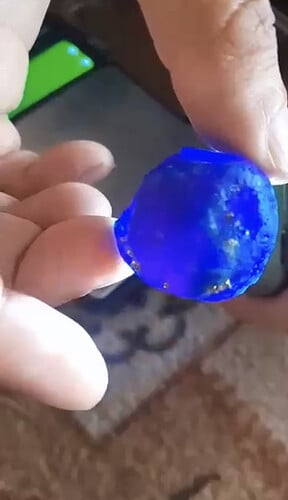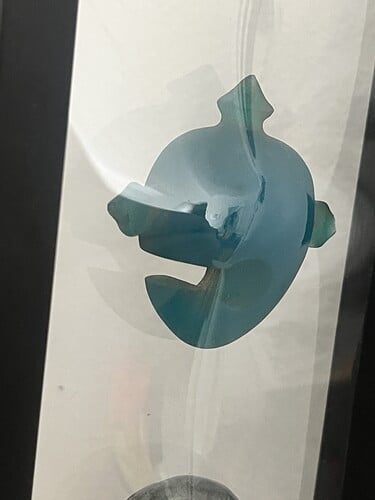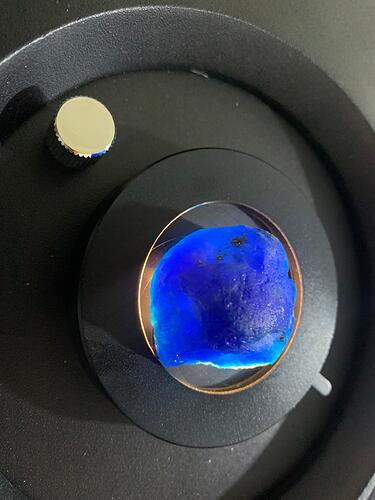We’ve stumbled upon a stunning blue stone, and we need your expertise! Take a look at the picture we’ve shared. Is it Sodalite? Lapis Lazuli? Or perhaps something even more exotic? ![]()
Without any other information it is very difficult to ID gemstones from just pictures. If i had to guess I would say that the stone is either a sapphire, or some other dyed gem. More information would help others give you their opinion.
Best of luck!
-Daniel
This is from north site of Afghanistan, Badakhshan, we will receive and gems soon and wil send you proper pictures!
Could be lapis or a missing Christmas ornament. Without further information it is difficult to say.
As others have said, it’s hard to say from just the picture, but it could also be glass (obsidian/tektite or symthetic). I have seen (and have examples of) tektite glass that looks quite similar, some of which (for example from the Khmer regions of SE Asia) is very intricately crafted/worked. It measures differently than lead or some other types of common synthetic glass, and to me, the colors seem much more radiant.
Afghanistan was a hugely important region for ancient trade in gemstones and other minerals for many millennia. It is also a hugely important place in human history, a large part of the “Oxus Civilization” (Bactria Margiana Archeological complex), and later the Greco Bactrian Empire, Sassanid empire, birthplace of Zoroaster, Rumi and countless others. It was central to the southern Silk Road and the crossroads where it split toward Samarkand and the Indus Valley, for example, in the north and Persia/Mesopotamia to the West. Many gems and other minerals from as far away as the Mediterranean and Burma/Indonesia have turned up there, so whatever it is, it’s cool and probably very ancient.
Please do a SG test and an RI test if you have the tools. Then let us know the results.
Example of misunderstanding of a “gem” was my Grandma’s “ruby”, when I inherited the very worn gold ring, it turned out to be colored glass. The gold was 18 KT. Seems my Grandma’s husband was took by the jeweler in town.
As others have said, hard to tell from the images but could be synthetic sapphire. What appear to be metallic inclusions could be from the crucible it was made in.
Because it looks translucent in your pictures, and a pure blue without mottling or pattern, I doubt it is lapis or sodalite. If you have or can borrow a $15-$20 gram scale, you can glue a piece of string to the stone and get an SG. PM me if you need instructions on how to do this, it is very simple and gives you a start to rule in or out corundum and glass. It looks too big and too pure in color to be natural corundum, but who knows. -royjohn
Thanks, yes plz let me know how to so it?
It could be hauyne, or lazurite. It appears to have pyrltes inclusions which suggests the latter
Lapis, before and after tumbling.
It looks like Chalcanthite to me although a bit dark in the middle photo. The bright blue makes me think of Chalcanthite but It’s likely not that. I certainly do not believe it is any kind of a Tektite either. I have several kinds and NONE are anywhere near that Hue (Blue) or that internally clean.
I also believe it is far too translucent to be Lapis or anything like that either.
In fact, I’m going to guess “GLASS” !
You can’t possibly get an accurate ID from a photo that has absolutely no info or context. This is science. What evidence do you have that can support theories on its ID? Where did the “stone” come from? What is the geology of that area? It isn’t showing a typical crystalline structure, has it been tumbled in water? What gems have similar colors/form/structure to this? Does it fluoresce? As mentioned by others… what is the specific gravity? How hard is it and what marks it?
From the photo you have posted, it looks like it’s reasonably transparent and obviously pretty big for a single “crystal”. This rules out lapis because it isn’t transparent. Sodalite can be, but it’s not that common to see it in such a clean form. Both lapis and sodalite tend to show bands/inclusions of minerals from the surrounding environment.
If it were a tumbled sapphire, you would probably already know because you would have fossicked for it and you would be well aware of its rarity and value (no one in their right mind would part with it unless there was a stack of money in front of them).
It looks like a piece of glass. Maybe a marble or bottle top. Perhaps slag. The texture, colour, transparency etc etc… I google searched your picture and pull up with everything from slime and jewellery wax, to fake moldavite, Ceylon sapphires and seaglass.
I strongly recommend you look up gem and mineral identification to learn the basics and perhaps look around your local area for a reputable gemologist who might be willing to give you a hand.
Not lapis.
Do a conductivity test.
Then perform a refractory test.
Might narrow down type.
Quick correction (and a photo)…
I referred to the Khmer region of SE Asia in my initial reply as the source of blue (and other colored) glass, which your piece may or may not be. Although there was/is a great deal of cultural exchange in that region, I think technically the cultures most associated with such amazing glass are those of the northern Laotian regions, and those of northern Thailand, Vietnam, Southern China, and Western Myanmar. Here is an ancient example (sorry about pic quality, it was in a display frame). I do not know if this is natural or human-made glass (ie a tektite or obsidian, both of which are regular found in that region in multiple colors), but it’s an ancient place with a metal-working tradition of the highest caliber dating to at least 3000BC, so both are quite possible; the tech/techniques for art and ritual artifacts rival any other region of the ancient world.
I’m going to with glass, human made or otherwise.
If it comes from a mineable deposit then it’s worthwhile getting a Laser Inductively Coupled Mass Spectrometer reading on it. Only a small chip will suffice to give you mass fractions of the major elements in it down to the parts per million level and a quick identification of its composition. Also, if you have a scan on lapis lazuli from Afghanistan it will verify that source by reason of the latter’s “chemical fingerprint”. The above presumes that you have a sample that properly represent your mineable quantity.
LA ICP MS will give you all the information that is needed and more, however, it’s very costly… academic and commercial labs will do it at a rate of $100 +/- $50 per hour…takes several hours with repeat runs to confirm elemental and isotopic contents… Not worth the cost unless routine testing plus expert in person gemmological opinion points to something that is very valuable.
see my post on LA ICP MS… if you know of a reliable testing center that does it flat fee for a cheap price, please let me know…Sensitivity is down to 10’s ppb… Time of flight MS a further refinement.





